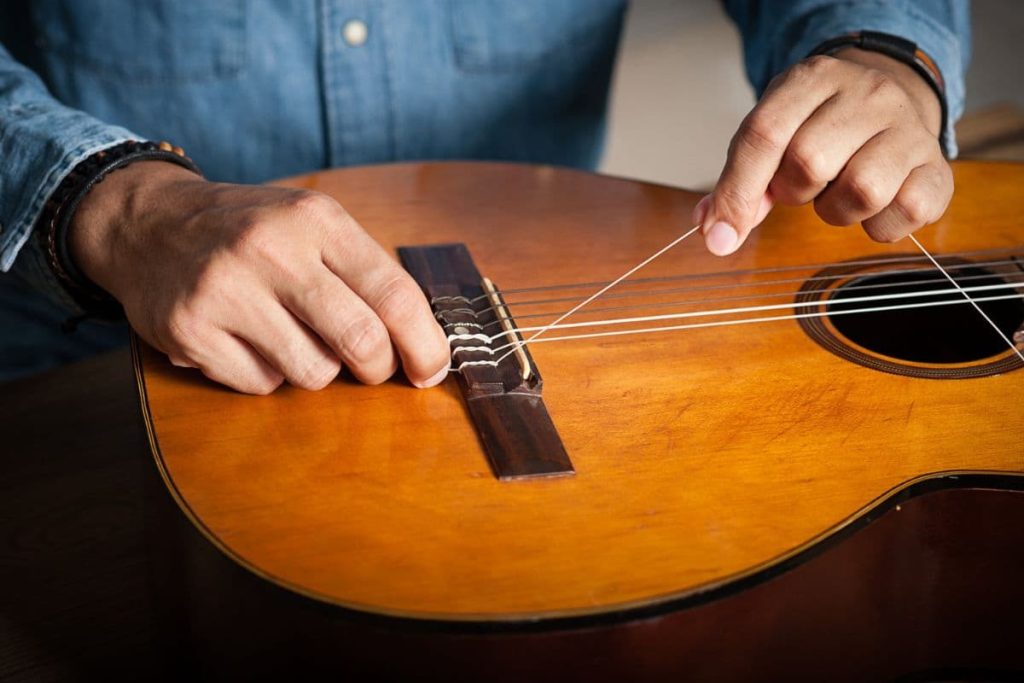Acoustic guitars can sound bright, full, resonating, and beautiful. However, they should never sound tinny or toyish. Tinny strings typically mean there’s something wrong with the strings or the instrument. That being said, there are various reasons your acoustic guitar might sound more tinny than usual.
Your acoustic guitar sounds tinny because the strings need to be broken in, they’re too thin for your liking, or the action is too high. Other causes include low-end guitars, low action, and recording equipment issues. Make sure you know how to adjust your amplifier and digital audio workstation.
Throughout this article, you’ll discover why your acoustic guitar sounds so tinny and what you can do about it. You’ll also find out about a few ways to tweak your digital equipment to work in your favor.
If you want to find out what my recommended guitar gear is, then here is what I recommend on Amazon:
- Fender Cutaway Acoustic-Electric Guitar Bundle (MY FAVORITE GUITAR)
- Snark SN-8 Super Tight All Instrument Tuner (Easiest Tuner I’ve Used)
- 6 String Acoustic Guitar Capo (Best CAPO for quick changes)
- Dunlop Max Grip 1.0mm Nylon Picks (Thick Guitar Pick So You Don’t Lose Grip!)
- Universal Guitar Stand (Cheap & Minimalist Guitar Stand I Recommend)
- Levy’s 2″ Wide Quick Adjust Guitar Strap (Best Guitar Strap For Any Level)

New Strings Need to Be Broken In
Your guitar strings need to be broken in to prevent them from sounding tinny. Sound Adventurer explains brand-new strings have a metallic sound because they haven’t been stretched and used. The good news is that the quickest way to solve this common problem is to play your acoustic guitar more often.
Breaking in the strings loosens the metallic composition. When they’re too tight and new, they carry the metal noise. However, they quickly dull to the bright, warm sound people know and love in acoustic guitars. Play your instrument several times a week to break in the strings. You can stretch the strings manually.
To bend your guitar strings, hold the top of a string and push it up and down with the other hand. Do this to each string, tune the instrument, then repeat the process. Stretching the strings will slightly affect the tuning, so it’s essential to tune them after stretching them. This includes those who use bending techniques to alter the tone while playing.
Low-Quality Guitars Sound Tinny
Low-end guitars aren’t the best for those looking for clear, crisp sound and high-end intonation. If your guitar is cheap, you should expect it to sound toyish and tinny. This unwanted noise is very difficult to correct. In fact, the only solution is typically to get a brand-new acoustic guitar that’s a bit better and has high-quality materials.
Here’s a list of reasons low-quality acoustic guitars sound tinny:
- The guitar’s body is made of thin, cheap materials. Thin acoustic guitars don’t produce as much bass as thicker, full guitars. The thinner construction can make the guitar produce a tinny sound that can’t be removed since it’s caused by the shape and size, not the materials.
- The nut, bridge, and other parts aren’t high-quality. Each component on an acoustic guitar directly affects how it sounds. If you have a high-end guitar with cheap parts, it’ll sound tinny or muddy. Make sure the nut and bridge are made with stock materials, bone, aluminum, and so on.
- The acoustic guitar might’ve come with low-end strings. If you bought a budget-friendly acoustic guitar, the manufacturer likely provided low-cost strings. The good news is that you can add a high-end set of strings for less than $10 in most places. Head to a local shop to find out which ones suit your guitar.
- There are holes or scratches inside the guitar. An acoustic guitar’s body changes its resonance, sustain, and volume. If there are holes, scratches, and broken parts in the guitar, there’s no doubt it’ll sound different. Too many scratches will make the guitar sound sharp and hollow, which sounds quite tinny.
- The inner parts are loose. Many acoustic guitars have pickups, built-in tuners, and other internal components. If anything in the guitar is loose, it’ll bounce around and change the way the strings vibrate. These vibrations turn from circular to ovular, which makes them buzz and sound tinny.
Thin Strings Have More Treble
If you have light strings, they’ll sound brighter and higher than you might be used to. Upgrade your strings to be a bit thicker if you want to increase the bass and reduce the treble. Again, more treble typically means a slightly more tinny sound. A 0.08” gauge string will be much higher and tinnier than a 0.012” gauge string.

When you switch to thick strings, you might have to adjust your playstyle. Heavy strings are harder to press. We suggest going up one or two gauges instead of grabbing the thickest, heaviest strings you can get your hands on. Once you’re used to the new strings, you can decide if you want to go higher or lower.
The Action Is Too Low
Low action and high action cause numerous acoustic guitar problems. If your guitar looks bent inward or outward, the truss rod needs to be adjusted. Contrary to popular belief, the truss rod isn’t the only part of the guitar’s action. However, it’s one of the most influential pieces of the puzzle. Adjusting will often instantly prevent buzzing and tinny sounds.
Follow these instructions to fix a low action on your acoustic guitar:
- Adjust the truss rod with an Allen key. The truss rod plays a major role in the guitar’s action. When the truss rod is too tight, the guitar’s neck will look bowed. When it’s too loose, the guitar will be bent outward. The goal is to rotate the adjustment nut with the Allen key until the guitar’s neck is flat without buzzing the strings.
- Check the saddle and nut. The saddle holds the strings at the base over the bridge. If the action is too low, the saddle might need to be replaced. The same rule applies to the nut at the top of the strings. These parts slowly wear down from using tight strings and moving the nut and saddle too much.
- Make sure the bridge pins are secured. The bridge pins hold the strings onto the bridge. If the pins are loose, they’ll cause the strings to buzz against the saddle. It can also make the strings buzz against the frets if they’re too low. The pins should be flush with the bridge.
- Fix the tuning pegs if necessary. Loose tuning pegs can make the strings buzz against the nut at the top of the acoustic guitar’s neck. Tuning pegs gradually loosen from the string’s constant tension. You can unscrew the tuning pegs with a screwdriver, but make sure you remove the strings beforehand.
- Monitor the bridge. The bridge supports the pins, strings, and saddle. If the bridge falls off or becomes misaligned, everything on the guitar won’t work. The bridge should be centered and secured to the guitar with an adhesive. Take it to a guitar repair shop rather than DIYing the repair.
Your Guitar’s Pickup Is Misaligned
If the pickup is too close to the neck, your guitar will undoubtedly sound tinny. Many acoustic guitars have the pickup closer to the bridge because it highlights the bass tones. However, DIY installations could place the pickup in the wrong location. Furthermore, slanting the pickup will increase the treble and decrease the bass.
If you have a pickup in your guitar, make sure it’s not dangling or loose. Much like the other loose components listed on this post, a dangling or loose pickup causes several sound issues. All of the wires need to be tightly secured to the inside of the guitar with zip ties (or whatever adhesive you choose).
Your Recording Equipment Is Malfunctioning
According to Strum Like a Pro, your recording equipment directly impacts your acoustic guitar’s tinny, muddy sounds. If your guitar sounds too dull or sharp, there’s a high chance that your recording gear has an error or two. The good news is that all recording problems can be fixed quite quickly if you know where to start.

Try these suggestions to fix this common cause of tinny acoustic guitar noises:
- Make sure all of your cables are completely connected (and that you have the right cables for the acoustic guitar). Loose cables will alter your recording equipment. Some acoustic guitars need specific cables, so it’s important to ensure that you have the correct connections beforehand.
- Consider the audio interface you’re using (or lack thereof). A high-quality audio interface will provide high-end, clear sounds. If you use a cheap AI, you should expect a tinny, toyish sound in your recordings. You can use the best DAW and guitar, but a low-end audio interface can ruin everything.
- Make the necessary adjustments to your digital audio workstation. A digital audio workstation (DAW) lets you record and edit your acoustic guitar’s soundtracks. Adjust the treble and bass if possible. Too much treble will make your acoustic guitar sound tinny. You can also make this adjustment on the guitar’s pickup.
- Consider your device’s sound system. If the guitar’s recording is coming through a laptop’s built-in speakers, it probably won’t sound great. Instead, plug in a set of high-end speakers. You could also use headphones if you don’t mind playing and recording into your ears rather than amplifying the noises.
- Check if your amplifier is in good condition. An old, worn amplifier (or a cheap setup) will undoubtedly worsen your acoustic guitar’s sound quality. If the amp’s speakers blow out, you might not have the same crystal-clear audio you’re used to. Don’t forget to reduce the treble if it sounds too tinny.
Some String Materials Sound More Tinny
Steel strings are notorious for boosting your guitar’s treble. While it sounds great for some playstyles, steel strings ruin it for others. Thin steel strings will sound tinny and toyish, especially if your acoustic guitar has a thin body. Try bronze strings if you want to warm the tone coming out of the instrument, and don’t forget to break them in before analyzing the results.
On that note, check the material of the nut and saddle. These materials are typically made of plastic or bone, but some of them come with aluminum. If you have steel strings and an aluminum nut and saddle, the metal-on-metal tension will sound tinny and cheap. Choose one or the other if you have a thin, low-end acoustic guitar.

The Saddle or Nut Needs to Be Filed
If your acoustic guitar’s saddle or nut is too high, they’ll adjust the action. Furthermore, a slanted or misaligned nut or saddle will make your instrument sound tinny or dull. You can file the bottom of the nut or saddle to alter the sound output. Ensure you don’t file the top of either piece unless you want to deepen the groove in the nut.
So, how should you file the nut and saddle?
- Acoustic Guitar claims you should file the underside of the saddle and nut. Filing the top of the saddle will ruin the sound of the strings. The saddle has unique angles that support each string. They also promote optimal action because some of them have to be raised a small distance more than the others.
- Make sure both parts are as flat as possible underneath. Place the nut and saddle on a flat surface. If there’s any light coming underneath the saddle or nut, file them until there isn’t. Never file the saddle and nut too much, or they’ll reduce the action so much that you can’t play the guitar without buzzing the strings.
- You can deepen the guitar’s grooves to accommodate thicker strings. Use a filer to increase the depth on each of the nut and saddle grooves. When thick strings sit in shallow grooves, they stretch, bend, and buzz. These unwanted noises make the acoustic guitar sound quite tinny.
- Always use a guitar filer. The iLuiz Guitar Filer Set comes with more than enough files to correct your acoustic guitar’s nut, bridge, and frets. It comes with multiple file sizes, so you’ll have no problem getting your acoustic guitar strings grooved and tuned in no time. The kit also includes sandpaper for broad filing.
- Work in slow, gentle motions with a filer. Even the toughest nut and saddle are brittle compared to most guitar parts. Abrasive, rough filing motions will crack and destroy these components. A small amount of filing will do more than enough to correct uneven shapes and action problems.
The Strings Are Overstretched
While it’s important to stretch your acoustic guitar’s strings, stretching them too much will highlight the tinny, metallic tones. Unfortunately, this is a natural occurrence from wear and tear. There’s no way to avoid stretching your guitar’s strings, but using various bending techniques will undeniably expedite the process.

Another way that you might stretch your acoustic guitar strings too much is if you tune them too high. While some people change their guitar’s key through various tuning methods, high-pitched tuning always stretches the strings more than they’re used to. Compressing and stretching the strings repeatedly will inevitably ruin them.
Fretting and Strumming Mistakes
Although most tinny acoustic guitar sounds come from hardware and software issues, you might be holding the guitar incorrectly. Fretting, strumming, and fingerpicking incorrectly can cause tinny noises, buzzing, and more. However, you can fix these problems by slightly adjusting the way you play the instrument.
Consider these minor adjustments to prevent fretting and strumming issues:
- Always keep your strumming hand’s pinky planted on the guitar’s body. This beginner technique will carry you through your acoustic guitar journey. Planting the pink provides stability and prevents your hand from muting the strings. It’s also a great tool for fingerpicking patterns.
- Make sure your palm doesn’t touch the strings with either hand. Palm muting is a classic technique that lets you make your acoustic guitar much quieter. However, accidentally muting the strings with your palm will make them buzz and sound tinny. Make sure both of your palms never touch the strings unless you are palm muting.
- Learn how to play your favorite chords in the easiest way possible. You can play a D chord in three or four ways. You can play a C chord in many ways too, and the same applies to almost every other chord on the acoustic guitar. Find out which finger orientations let you fret the chords without touching unintended parts of the strings.
- Keep your fingers as centered between the frets as you can. If your fingers touch the metal bars on the frets, they’ll cause unwanted buzzing noises. These sounds make the guitar sound tinny, which ruins its performance and resonance. Your fingers should firmly press each string at the center of each fret.
- Consider clipping your nails if you fingerpick the acoustic guitar. Many people who fingerpick grow their nails because it mimics using a traditional pick. However, longer fingernails also increase the treble of the instrument. When the treble is too high, your guitar will sound toyish and tinny.
Final Thoughts
Tinny acoustic guitars can ruin your performance. It’s important to choose the right strings, cables, hardware, and software. However, you shouldn’t overlook the action, saddle, nut, and other parts of the acoustic guitar. Go through the list and check off each factor before determining the primary source of the tinny sounds. Good luck!
If you want to find out what my recommended guitar gear is, then here is what I recommend on Amazon:
- Fender Cutaway Acoustic-Electric Guitar Bundle (MY FAVORITE GUITAR)
- Snark SN-8 Super Tight All Instrument Tuner (Easiest Tuner I’ve Used)
- 6 String Acoustic Guitar Capo (Best CAPO for quick changes)
- Dunlop Max Grip 1.0mm Nylon Picks (Thick Guitar Pick So You Don’t Lose Grip!)
- Universal Guitar Stand (Cheap & Minimalist Guitar Stand I Recommend)
- Levy’s 2″ Wide Quick Adjust Guitar Strap (Best Guitar Strap For Any Level)
Why Does Your Acoustic Guitar Sound Tinny Related FAQs
How do I stop my acoustic guitar from sounding tinny?
To stop your acoustic guitar from sounding tinny, you can try adjusting the EQ settings on your amp or PA system, using a different set of strings, changing your playing technique, or using a different mic placement if recording.
Why does my acoustic guitar sound so metallic?
An acoustic guitar can sound metallic due to a variety of reasons, such as the type of strings used, the guitar’s construction, or the playing technique. It can also be a result of poor EQ settings on the amp or PA system.
How do I make my guitar sound less tinny with EQ?
To make your guitar sound less tinny with EQ, you can reduce the high frequencies on the EQ and increase the mid-range frequencies. This can help to warm up the tone of the guitar and reduce the tinny sound.
Why does my acoustic guitar sound brassy?
An acoustic guitar can sound brassy due to a variety of reasons, such as the type of strings used, the guitar’s construction, or the playing technique. It can also be a result of poor EQ settings on the amp or PA system.
How can I make my acoustic guitar sound clearer?
To make your acoustic guitar sound clearer, you can try adjusting the EQ settings on your amp or PA system, using a different set of strings, changing your playing technique, or using a different mic placement if recording.
How do I make my guitar sound clear?
To make your guitar sound clear, you can try adjusting the EQ settings on your amp or PA system, using a different set of strings, changing your playing technique, or using a different mic placement if recording.
How do I make my acoustic guitar shiny?
To make your acoustic guitar shiny, you can use a guitar polish or wax specifically designed for use on acoustic guitars. Be sure to follow the manufacturer’s instructions carefully.
How do I know if my acoustic guitar is bad?
If your acoustic guitar has issues such as poor intonation, buzzing frets, or a warped neck, it may be considered a “bad” guitar. However, the sound and tone of an acoustic guitar can be subjective and what may sound bad to one person may not be bad to another.
Will changing my guitar strings make it sound better?
Changing your guitar strings can improve the sound and tone of your guitar, especially if the old strings were worn out or of poor quality.
Why does my song sound tinny?
If your song sounds tinny, it could be due to a variety of reasons such as poor EQ settings, improper microphone placement, or the use of low-quality recording equipment.
What is the best EQ setting for acoustic guitar?
The best EQ setting for acoustic guitar can vary depending on the individual guitar and the player’s preferences, but a common starting point is to boost the mid-range frequencies while reducing the low and high frequencies.
What frequency should I mix my acoustic guitar?
The frequency at which you should mix your acoustic guitar can vary depending on the song and the arrangement, but the mid-range frequencies are typically the most important to emphasize.
How do I make sound less metallic?
To make sound less metallic, you can try adjusting the EQ settings on your amp or PA system, using a different set of strings, changing your playing technique, or using a different mic placement if recording.
Related Posts:

